Newsletter
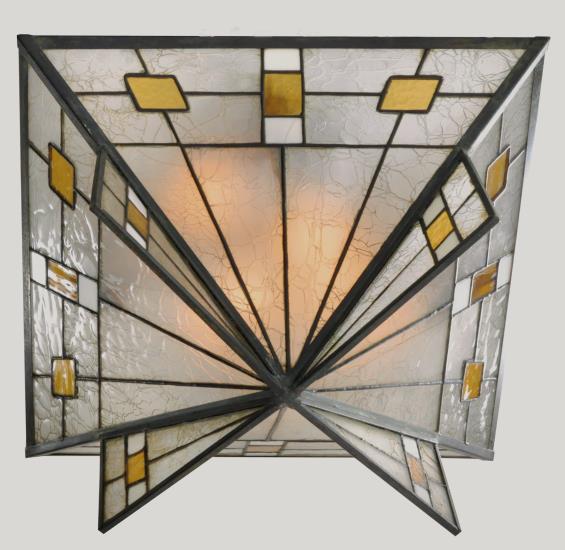
Chandelier for the Emil T. Mueller house, La Crosse, Wisconsin. 1915-1916. Slag, craquelure glass and metal.
The development and emergent use of the electric light bulb in the late years of the nineteenth century prompted designers and craftspeople to consider a host of ways in which the new light source might be utilized not only for practical application, but for artistic affect. The bare bulb may have spoken directly to the triumph of this new technology, but the proponents of the Arts and Crafts movement saw instead opportunities for diverse expressions that suggested everything from the glow of sunlight as seen in the lamps of Louis Comfort Tiffany to the architectonic echoes of the Prairie School designers. The latter group’s predilection for art glass windows as well as use of the electric bulb for indirect and direct lighting reflected a sophisticated blend of influences – including Japanese aesthetics – that ultimately helped them realize a modern architectural expression for the new century. Lighting, both natural and artificial, was an integral component of this effort.
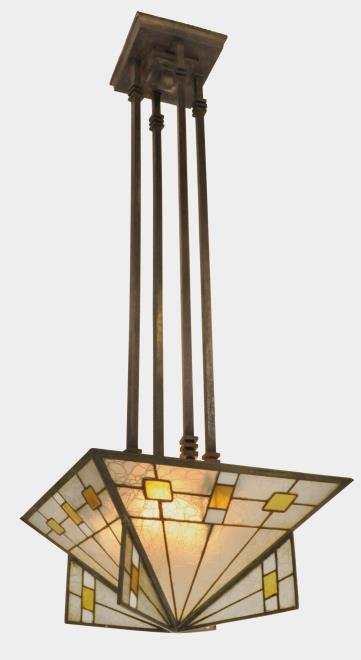
Full view of chandelier for the Emil T. Mueller house, La Crosse, Wisconsin. 1915-1916. Slag, craquelure glass and metal.
The Two Red Roses Foundation collection contains a rich selection of early twentieth century lighting fixtures that will be the subject of a forthcoming publication “Radiance: Arts and Crafts Electric Lighting: Beautiful, Useful, Inevitable” by David Cathers. Among these works, electric lamps by Frank Lloyd Wright, George Mann Niedecken, and George Washington Maher represent the work of the Prairie School alongside superior examples by lesser known architects and designers. The shared aesthetic of typically boxy, lantern-like leaded shades with geometric designs including pronounced linear elements provided a vocabulary of motifs that were eagerly worked and reworked by designers known and unknown, including those of one of the Foundation’s leaded glass chandeliers that loosely recalls Wright’s own ceiling fixture designs, notably those of the Francis W. Little House (1902) in Peoria, IL. This particular fixture was reputed to have been located in the William Prindle House (1904-05) in Duluth, Minnesota, a residence that included eclectic interiors created by John Scott Bradstreet (1845-1914).
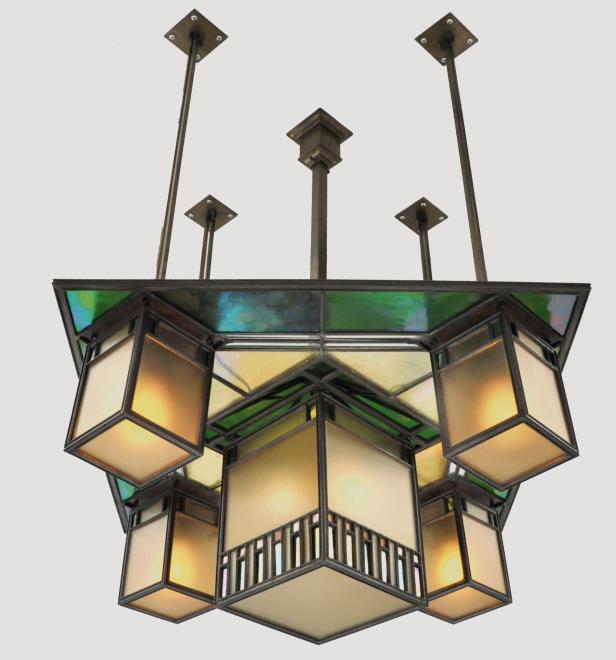
Chandelier, ca. 1902. Colored and iridescent glass, metal.
Another hanging fixture, designed by architects Percy Dwight Bentley (1886-1968) and Charles Albert Hausler (1889-1971) for the Emil T. Mueller House (1915-16) in La Crosse, Wisconsin utilizes an inverted pyramid-form leaded shade decorated with rectangular and square colored glass elements to provide a design in harmony with the Wright-influenced design. Bentley was certainly familiar with the work of Wright and his design collaborator Niedecken, having worked with the latter in the creation of the furnishings and fixtures for the Henry A. Salzer House (1912), also located in La Crosse.
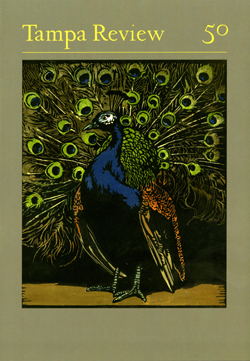
When asked by the editor of the highly respected literary journal Tampa Review if the Two Red Roses Foundation would consider having objects from its collection featured in the Review’s 50th Anniversary Edition, it answered with a resounding “yes!”. TRRF’s founder, Rudy Ciccarello, and the Review’s editor, Richard Mathews, spent weeks carefully selecting a wide-ranging group of objects illustrative of the collection including woodblocks (on the cover: William Seltzer Rice’s Pride Steps Forth) pottery, furniture, metalwork, tiles, photography and stained glass. The Review’s first-ever color issue celebrates the creative interplay of contemporary literature and visual arts. This issue also contains black and white images of works by Stieglitz, Steichen, Mortensen, and Coburn.
Tampa Review is published twice each year by the University of Tampa Press, a non-profit publisher. Founded in 1964 as University of Tampa Poetry Review, Tampa Review is the oldest continuously published literary journal in Florida. Each issue features new art and writing from Florida and around the world, presented in an elegant hardcover format that serves as a gallery space in print. Rooted in the literary and artistic Tampa Bay community, the Review has a strong affinity with the American Arts and Crafts Movement and strives to represent the highest artistic standards.
Tampa Review's 50th Anniversary is available for sale on our webpage. For a preview, click here.
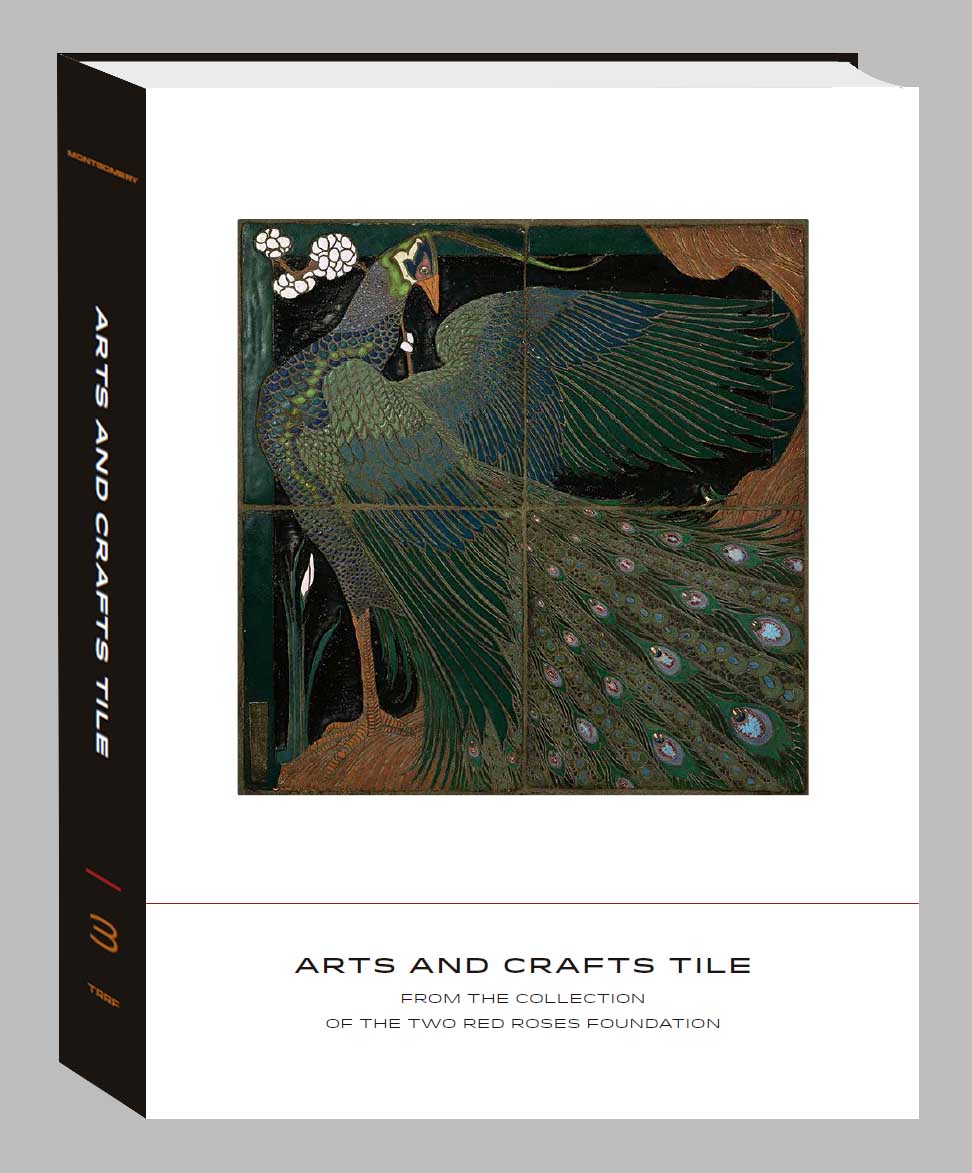
In this book, the Two Red Roses Foundation shows its commitment to provide a historic and scholarly record of tiles and architectural faience from its collection. Author Dr. Susan Montgomery, whose research and writing on the subject exceeds expectations, explores in great detail the works of sixteen of the most prominent tile makers of the Arts and Crafts movement and more than 165 objects from the TRRF’s collection. From individual tiles, large and small, to running friezes, wainscots, fireplaces, panels, and entire room and outdoor installations, the book investigates and speaks to the ideals of tile design, craftsmanship, competition and production against the backdrop of the financial challenges and realities the tile makers faced. More than six years in the making, this handsomely designed 360 page catalogue contains hundreds of high-definition color images, historic facts and figures. An extensive bibliography and index makes it a most valuable reference for collectors and scholars.
The manuscript is off to China to be printed and will be available on February 1st, 2016. The Foundation has invited Dr. Montgomery to attend the 2016 Annual Arts and Crafts Conference at Grove Park to participate in a book signing.